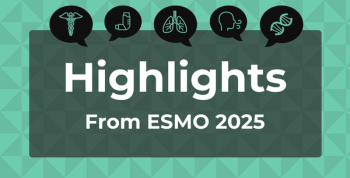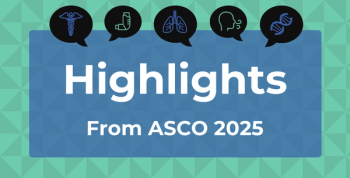
Biologics Relieve Ear-Related Symptoms Linked With Asthma, CRwNP
Key Takeaways
- Biologic therapies for asthma and CRSwNP may reduce ear-related symptoms, including otitis media, ear fullness, pain, and dizziness.
- A retrospective analysis showed significant improvements in otologic symptoms after 12 months of biologic treatment, as measured by SNOT-22 and EOS-16 scores.
Biologic therapies for severe asthma and chronic rhinosinusitis with nasal polyps (CRSwNP) significantly improved ear-related symptoms, enhancing patient quality of life and treatment outcomes.
Biologic therapies prescribed for
The findings, published in
Many patients with asthma and CRSwNP also experience otitis media (OM) and other ear-related issues, such as ear fullness, pain, and dizziness. Despite this common co-occurrence, the effect of biologic medications on these symptoms had not been widely explored, the authors explained.
“Refractory OM could be included as a sign of multimorbidity in the international guidelines for biologic medication in cases of severe uncontrolled CRSwNP,” the authors wrote. “The number of studies with a few patients that describe the favorable effect of biologic therapy on symptoms of EOM [eosinophilic otitis media] is limited.”
The new study aimed to determine if type 2 anti-inflammatory biologics could improve patient-reported otologic manifestations.
The retrospective analysis included data from the electronic patient records of 40 patients who were prescribed biologics for either CRSwNP or asthma. All patients in the cohort had CRSwNP, and 90% also had a diagnosis of asthma. Clinical otologic signs were reported in 42.5% of the patient population prior to beginning biologic treatment. Although the main indications for therapy were CRSwNP and asthma, 3 patients (7.5%) were primarily prescribed biologics due to severe OM symptoms but also had asthma and CRSwNP. Dupilumab was the most common biologic therapy (75% of patients; n = 30), followed by mepolizumab (15%, n = 6), omalizumab (7.5%; n = 3), and benralizumab (2.5%; n = 1).
Two validated patient-reported outcome measures (PROMs) were used to determine the impact of biologics over a 12-month period: Sino-Nasal Outcome Test-22 (SNOT-22) and the otology-specific Ear Outcome Survey-16 (EOS-16). These surveys allowed patients to report on a range of symptoms, including ear fullness, dizziness, and pain.
The results showed a significant improvement in patient-reported symptoms at the 12-month follow-up, with SNOT-22 scores for all ear/facial domain questions significantly lower vs baseline. These included median scores for ear fullness (3 before treatment vs 1 after 12 months; Z = −3.434; P < .001), dizziness (2.5 vs 0.5; Z = −3.452; P < .001), ear pain (1.5 vs 0; Z = −3.097; P = .002), and facial pain/pressure (2 vs 0; Z = −3.133; P = .002). Median EOS-16 scores were also significantly lower before vs after biologic therapy (11.5 vs 3; Z = −2.791; P = .005). Beyond patient-reported data, the study also found that clinical otologic signs, as observed during physical examinations by an ear, nose, and throat specialist, improved significantly.
“This register study assessed the patient-reported reduction in otological symptoms evaluated by two validated PROMs, SNOT-22 ear/face domain and EOS-16, following biologic therapy prescribed for asthma or CRSwNP,” the authors wrote. “We found that biologics improved ear symptoms both subjectively on the basis of PROMs and objectively on the basis of clinical findings.”
The study limitations included data being included from both the authors’ medical center and from previous studies, as well as the use of register data. EOS-16 is also a relatively new PROM, potentially impacting its use, the authors noted. PROMs are also subjective in nature. Finally, there was no control group, and treating specialists were not blinded.
These findings suggest that the biologics, by targeting the underlying type 2 inflammatory pathways common to asthma and CRSwNP, are also effectively treating the eosinophilic inflammation that contributes to ear-related issues.
“Biologic therapy prescribed for asthma or CRSwNP significantly reduced patient-assessed otologic symptoms on the validated PROMs SNOT-22 ear/face domain and the EOS-16,” the authors concluded. “In addition, the specialist-assessed clinical control of OM improved. Biologics seem to offer an auspicious option for alleviating the challenging OM symptoms of patients with asthma and CRSwNP. Prospective studies are warranted to confirm these findings.”
References
1. Suikkila A, Lyly A, Saarinen R, Lundberg M, Hafrén L. Biologic therapy relieves otologic symptoms and signs in patients with asthma and chronic rhinosinusitis with nasal polyps. Laryngoscope Investig Otolaryngol. Published online July 24, 2025. doi:10.1002/lio2.70212
2. Fokkens WJ, Viskens AS, Backer V, et al. EPOS/EUFOREA update on indication and evaluation of biologics in chronic rhinosinusitis with nasal polyps 2023. Rhinology. 2023;61(3):194-202. doi:10.4193/Rhin22.489
Newsletter
Stay ahead of policy, cost, and value—subscribe to AJMC for expert insights at the intersection of clinical care and health economics.







































